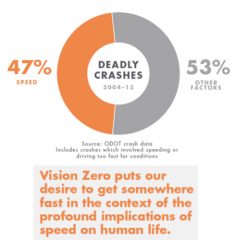
When Portland Bureau of Transportation management and staff heard about the new safety study focused on speed released by the National Transportation Safety Board on Thursday, their reaction must have been. “It’s about time!”
The report is making waves in transportation reform circles for its strong tone against the scourge of speeding and what should be done about it. The NTSB looked at crashes from 2004 through 2014 and found that speed was listed as a factor in nearly one-third of all fatal crashes. That led the NTSB’s Acting Chairman Robert L. Sumwalt to say, “You can’t tackle our rising epidemic of roadway deaths without tackling speeding.”
Here’s more from the NTSB press release:
“The NTSB found the relationship between speed and crash involvement is complex and is affected by a number of factors, however, speed – and therefore speeding – increases crash risk both in terms of the likelihood of being involved in a crash and in terms of the severity of injuries sustained by those involved in speeding-related crashes.
The study links speeding to 112,580 highway crash fatalities between 2005-2014. To put that number in perspective, nearly the same number of people – 112,948 – died in alcohol-involved crashes in the same period.
Despite this sobering statistic, speeding has few negative social consequences compared to the consequences of an arrest or conviction for driving under the influence. The study further notes that although drivers are aware that speeding is a threat to safety, they also acknowledge it is a common driving behavior in the US.”
Advertisement

To make roads safer, the agency made 19 recommendations to various state and federal agencies. Among them were several that will sound familiar to BikePortland readers: more speed cameras, more sensible (lower) speed limits, more high-visibility enforcement actions with local police, better data about where speeding occurs, and so on. Each one of those initiatives are already things PBOT is doing in some form or another in their war on speeding and related Vision Zero efforts.
Perhaps the most notable (and exciting) takeaway from the study is how it throws hefty skepticism at the all-powerful “85th percentile” rule that the federal government (and via trickle-down engineering standards) has used to set speed limits and design roadways for half a century. “Raising speed limits to match the 85th percentile speed can result in unintended consequences,” they write. “It may lead to higher operating speeds, and thus a higher 85th percentile speed… Alternative approaches and expert systems for setting speed limits are available, which incorporate factors such as crash history and the presence of vulnerable road users such as pedestrians.” (A BikePortland commenter shared a very helpful explanation about the folly of the 85th percentile approach yesterday.)
Just how big of a deal is it that a federal, independent investigative agency like the NTSB has come out swinging against speeding? All the evidence you need is in this pointed response from the National Motorists Association, an automobile users advocacy group. They accuse the NTSB’s study as part of a “draconian” plot to, “turn our highways into a for-profit police state.”
For more on the study check out the coverage on Streetsblog.
— Jonathan Maus: (503) 706-8804, @jonathan_maus on Twitter and jonathan@bikeportland.org
Never miss a story. Sign-up for the daily BP Headlines email.
BikePortland needs your support.

